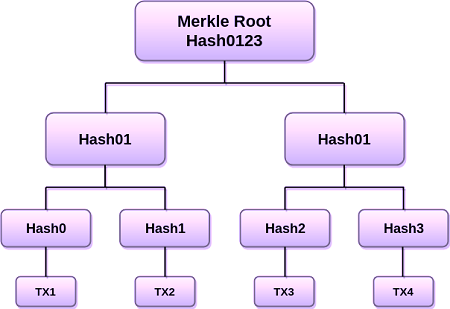Blockchain Merkle Tree
The Merkle tree is an essential component of Blockchain technology. It is a mathematical data structure composed of hash of various data blocks that serves as an overview of all transactions in a block. It also enables efficient and secure content verification in vast amounts of data. It also assists in data consistency and ingredient verification. Bitcoin and Ethereum both employ Merkle Trees. Merkle Tree is another name for Hash Tree.
Ralph Merkle developed the Merkle Tree idea, which he patented in 1979. It is a data structure tree with cryptographic hash of its own child nodes' labels on every non-leaf node and the hashes of the data block labeled on every leaf node. The leaf node is the tree's lowest node.
What exactly are Merkle trees, and how do they function?
A Merkle tree records all transactions in a block by creating a digital fingerprint of the entire collection of transactions. It allows users to see if a transaction can be included with the report.
Merkle trees are built by hashing node pairs until only one hash remains. Merkle Root or Root Hash is the name given to this hash. Merkle Root or Root Hash is the name given to this hash.
Every leaf node has transactional data, whereas every non-leaf node contains the hashes of its predecessors. Merkle trees must have an even number of leaf nodes since they are binary trees. If the volume of transactions is odd, the final hash will be duplicated once to establish a more even no. of leaf nodes.

The following example is a Binary Merkle Tree, which is the most frequent and basic type of Merkle tree. TX1, TX2, TX3, and TX4 are the 4 transactions in a block. The Root Hash, also known as the Merkle Root, is the top hash that is the hash of the whole tree. Hash 0, 1, 2, and 3 are generated by hashing each of them and saving them in each leaf node. Following Hash01, Hash02 & Hash03 are used to aggregate consecutive pairs of leaf nodes in a parent node, resulting in Hash023.The Root Hash or Merkle Root is produced by hashing the two hashes (Hash01 and Hash023) again.
The block header contains Merkle Root. The block header is the section of the Bitcoin block that is hashed throughout the mining process. It includes the Merkle Tree Root Hash of all transactions in the current block, a Nonce, and the preceding block's hash. As a result, putting the Merkle root in the block header secures the transaction. Because the Roots Hash includes the hashes of all transactions within the block, these transactions can result in disc space savings.
The Merkle Tree ensures the data's integrity. If any single transaction information or transaction orders changes, these changes are recorded in the hash of that transaction. This modification will propagate up its Merkle Trees to the Merkle Root, altering the Merkle Root's value & so invalidating the block. As can be seen, the Merkle tree enables a quick and straightforward test to determine whether or not a certain transaction is included in the set.
Merkle trees offer three advantages:
- It enables the preservation of data integrity and validity.
- It aids in memory or disc space savings since the proofs are computationally simple and quick.
- Their confirmations and administration necessitate the transmission of little quantities of data across networks.
What Does a Merkle Tree Look Like?
- Merkle tree, also called as Binary hash trees in comp science, are a common data structure.
- They use it to encrypt Blockchain data more effectively and securely in Bitcoin and other cryptocurrencies.
- That is a mathematical data structure composed of hash of different data blocks that total up all the transactions inside a block.
- It also allows for fast and safe content verification across large databases, ensuring data integrity and content.
What Does a Merkle Root, and What Does It Do?
- A Merkle root is a straightforward mathematical approach of verifying the facts on a Merkle tree.
- They're employed in cryptocurrency to make that data blocks delivered through a peer-to-peer network are complete, undamaged, and unmodified.
- They are critical in the computation necessary to keep cryptocurrencies such as Bitcoin and ether functioning.
Merkle Tree's Blockchain Advantages
Merkle trees offer 4 main benefits:
- Validate data integrity: It may be used to properly validate data integrity.
- Verification with Efficiency: The data format is efficient, and it just takes a few seconds to validate the data's integrity.
- The Merkle tree takes up extremely minimal disc space as compared to other data structures.
- Merkle trees may be split down into little chunks of data for verification and can be used across networks.